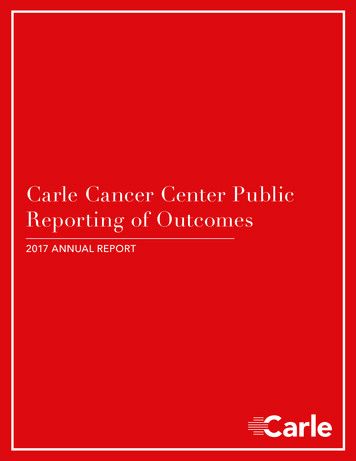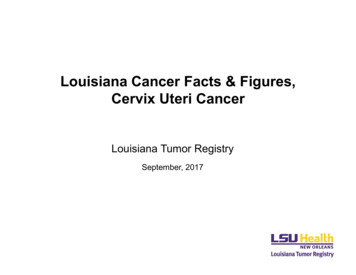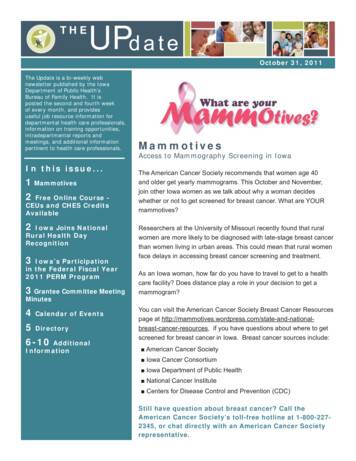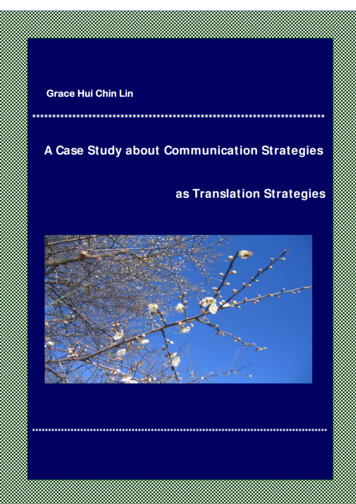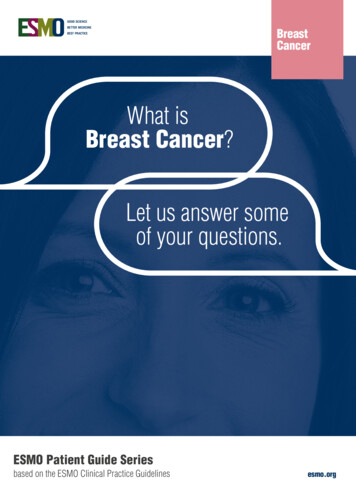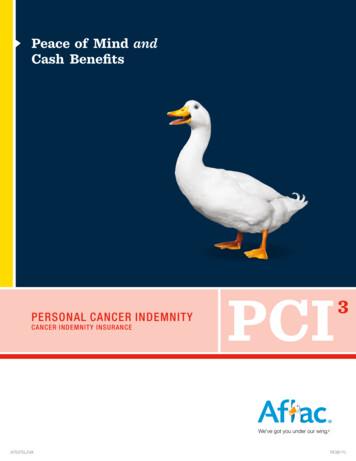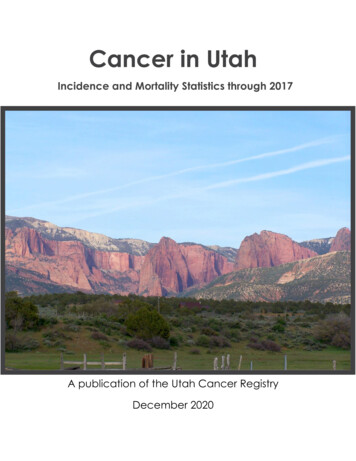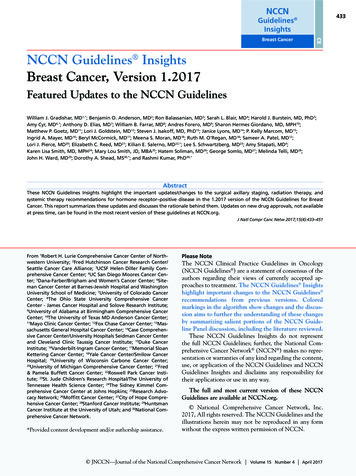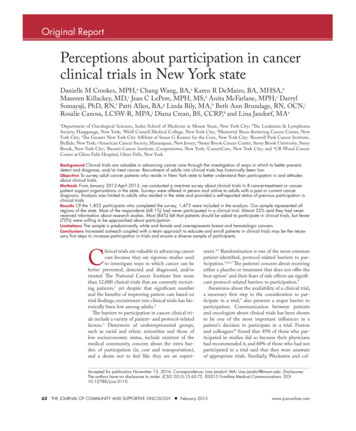
Transcription
Original ReportPerceptions about participation in cancerclinical trials in New York stateDanielle M Crookes, MPH,a Chang Wang, BA,a Karen R DeMairo, BA, MHSA,bMaureen Killackey, MD,c Jean C LePere, MPH, MS,d Anita McFarlane, MPH,e DarrylSomayaji, PhD, RN,f Patti Allen, BA,g Linda Bily, MA,h Beth Ann Brundage, RN, OCN,iRosalie Canosa, LCSW-R, MPA,j Diana Crean, BS, CCRP,k and Lina Jandorf, MAaaDepartment of Oncological Sciences, Icahn School of Medicine at Mount Sinai, New York City; bTe Leukemia & LymphomaSociety, Hauppauge, New York; cWeill Cornell Medical College, New York City; d Memorial Sloan-Kettering Cancer Center, NewYork City; eTe Greater New York City Afliate of Susan G Komen for the Cure, New York City; f Roswell Park Cancer Institute,Bufalo, New York; gAmerican Cancer Society, Manasquan, New Jersey; hStony Brook Cancer Center, Stony Brook University, StonyBrook, New York City; iBassett Cancer Institute, Cooperstown, New York; jCancerCare, New York City; and kCR Wood CancerCenter at Glens Falls Hospital, Glens Falls, New YorkBackground Clinical trials are valuable in advancing cancer care through the investigation of ways in which to better prevent,detect and diagnose, and/or treat cancer. Recruitment of adults into clinical trials has historically been low.Objective To survey adult cancer patients who reside in New York state to better understand their participation in and attitudesabout clinical trials.Methods From January 2012-April 2013, we conducted a one-time survey about clinical trials in 8 cancer-treatment or cancerpatient support organizations in the state. Surveys were offered in person and online to adults with a past or current cancerdiagnosis. Analysis was limited to adults who resided in the state and provided a self-reported status of previous participation inclinical trials.Results Of the 1,832 participants who completed the survey, 1,475 were included in the analysis. Our sample represented allregions of the state. Most of the respondents (68.1%) had never participated in a clinical trial. Almost 32% said they had neverreceived information about research studies. Most (84%) felt that patients should be asked to participate in clinical trials, but fewer(70%) were willing to be approached about participation.Limitations The sample is predominantly white and female and overrepresents breast and hematologic cancers.Conclusions Increased outreach coupled with a team approach to educate and enroll patients in clinical trials may be the necessary frst steps to increase participation in trials and ensure a diverse sample of participants.Clinical trials are valuable in advancing cancercare because they are rigorous studies usedto investigate ways in which cancer can bebetter prevented, detected and diagnosed, and/ortreated. Te National Cancer Institute lists morethan 12,000 clinical trials that are currently recruiting patients,1 yet despite that signifcant numberand the benefts of improving patient care based ontrial fndings, recruitment into clinical trials has historically been low among adults.2Te barriers to participation in cancer clinical trials include a variety of patient- and protocol-relatedfactors.3 Deterrents of underrepresented groups,such as racial and ethnic minorities and those oflow socioeconomic status, include mistrust of themedical community, concern about the extra burden of participation (ie, cost and transportation),and a desire not to feel like they are an experi-ment.4,5 Randomization is one of the most commonpatient-identifed, protocol-related barriers to participation.3,4,6,7 Te patients’ concern about receivingeither a placebo or treatment that does not ofer thebest option3 and their fears of side efects are signifcant protocol-related barriers to participation.8Awareness about the availability of a clinical trial,a necessary frst step in the consideration to participate in a trial,9 also presents a major barrier toparticipation. Communication between patientsand oncologists about clinical trials has been shownto be one of the most important infuences in apatient’s decision to participate in a trial. Fentonand colleagues10 found that 45% of those who participated in studies did so because their physicianshad recommended it, and 60% of those who had notparticipated in a trial said that they were unawareof appropriate trials. Similarly, Weckstein and col-Accepted for publication November 13, 2014. Correspondence: Lina Jandorf, MA; Lina.Jandorf@mssm.edu. Disclosures:The authors have no disclosures to make. JCSO 2015;13:62-72. 2015 Frontline Medical Communications. DOI10.12788/jcso.0110.62THE JOURNAL OF COMMUNITY AND SUPPORTIVE ONCOLOGYgFebruary 2015www.jcso-online.com
Crookes et alleagues11 reported that 44% of the patients they surveyedwho did not participate in a clinical trial could not recallhaving a conversation about clinical trials with their provider. Receiving information about appropriate clinical trials is an important facilitator to participation. Patients aremore inclined to participate in a clinical trial when theyare provided more information about the study.6 In addition, when patients perceive that their doctors want themto join trials, they may be more likely to accept recruitmentinto a trial.7Cancer is the second-leading cause of death in NewYork state and presents an important public health concern for health ofcials.12 Cancer incidence and mortalityare recorded through the New York State Cancer Registry,but there is no formal, publicly available resource to trackenrollment in clinical trials. Te New York State CancerConsortium (NYSCC) is a statewide coalition of organizations charged with the development and implementation of the state’s Comprehensive Cancer Control Plan.Tis plan is a roadmap to achieve reductions in cancer ratesand to improve outcomes for people who have been diagnosed with cancer. Te plan includes developmental objectives and strategies for increasing clinical trial enrollment.Although there has been research conducted at the international7 and national3,13 level on participation in clinicaltrials, to our knowledge, there has not been a statewideassessment of barriers and facilitators to clinical trial participation in cancer patients in the state of New York. Tus,an NYSCC subcommittee was formed to better understandthe attitudes and barriers to clinical trial enrollment in thestate.12 As part of the process of better understanding thoseattitudes and participation in clinical trials in the state, wereport fndings from a survey conducted from January 2012to April 2013 among adult patients who had ever receiveda cancer diagnosis and who currently resided in the state.MethodsFrom January 2012 to April 2013, we conducted a onetime survey about clinical trials in adults (aged 18 years orolder) who had ever received a cancer diagnosis. Te survey consisted of 38 items that captured participant demographics information (15 items), information about cancer diagnosis (2 items), trust in physician (1 item), previousexperience with and attitudes about clinical trials (5 items),perceptions about diferent elements of randomized trials(6 items), barriers and facilitators to participating in a clinical trial (4 items), modes of communication about clinicaltrials (2 items), and an open-ended question about facilitators for future studies (1 item). Patients who had previouslyparticipated in a clinical trial were also asked to rate theirclinical trial experience using a 4-point Likert-type scale(1 item) and to provide open-ended feedback about whatadditional information they would have liked to receiveVolume 13/Number 2that they did not receive when they participated (1 items).Many of the survey questions were drawn from previousliterature10,14 or were developed in-house. Data were collected without patients’ names or identifying information,with the exception of patients’ zip codes.Te survey was administered by 8 organizations in thestate: 3 cancer-patient support organizations, 2 academiccancer centers, and 3 community hospitals with oncology programs. Organizations were recruited through networks of the NYSCC. Eligible organizations had to belocated within the state, either provide cancer treatmentor be a cancer-patient support organization, and had tohave a champion who was willing to manage data collection. Internal review board (IRB) approval was initiallyobtained at the Icahn School of Medicine at Mount Sinai(ISMMS). Each of the coordinating organizations eitherrequested their own IRB approval or received administrative approval to use the ISMMS approval. Waiver of documented signed consent was granted for the conduct ofthis study, and all participants were provided with a writtenconsent summary prior to completion of the survey.Based on the needs of the participating organizations,the survey was administered on paper and online. Te 5patient-care organizations administered a paper versionof the survey through face-to-face interviews, participantself-completion, and telephone interviews. Recruitment atthese organizations took place in cancer-patient care areassuch as medical and radiation oncology waiting rooms.Paper surveys were ofered in English and Spanish. Faceto-face and telephone interviews were done by either volunteers or staf at each site. Te 3 patient support organizations administered an identical online version of the surveyusing SurveyMonkey. Sites e-mailed the link to existinge-mail contact lists and allowed the participants to fll outthe survey anonymously. Because previous communication with listserv and e-mail contacts had always been inEnglish, the online survey was ofered in English only.Data analysis was completed using SPSS version 20.Pearson chi-square and t test statistics were used to measure associations between previous participation in clinicaltrials and demographics and attitude variables. All of theassociations were considered signifcant at the 5% signifcance level.ResultsDuring the study period, 1,832 patients completed the survey – 479 (26.1%) on paper and 1,353 (73.9%) online. Ofthose, 1,492 (81.4%) met eligibility criteria (aged 18 yearsor older, had a cancer diagnosis, currently resided in thestate) and were included in the study. Of the eligible 1,492respondents, 1,475 (98.8%) answered prompts about theirprevious participation in research studies and thus wereincluded in this analysis.February 2015gTHE JOURNAL OF COMMUNITY AND SUPPORTIVE ONCOLOGY63
Original ReportDemographicsAs seen in Table 1, the sample included residents ofthe state’s 11 regions, with most of them residing inNew York City (24.7%), Long Island (17.6%), HudsonValley (12.3%), Finger Lakes (11.9%), and CentralLeatherstocking (10.1%). Te sample was predominantlyfemale (72.7%), white (85.5%), non-Latino (94.3%),and partnered (including married, living with a partner,and partnered but living alone; 71.1%). Te median agewas 57 years (SD, 11.53). Just over half of the samplewas employed (53.6%), of whom 68.6% were employedpart time. Most respondents (67.5%) reported anannual income of 50,000 or more, and most (75.9%)had completed some college education or higher. Temost common cancer malignancies reported were breast(38.4%), lymphoma (12.5%), and leukemia (9.0%). Acomprehensive list of all cancers represented in thesample is provided in Table 1. Most diagnoses (64.1%)had occurred within the previous 5 years.Most respondents (86.3%) reported that in the previous year they sought medical care when they needed to,and 86.1% reported following doctor’s advice and referrals when provided. Nearly 88% agreed that they trustedtheir oncologist to put their medical needs above all else.In all, 1,005 of respondents (68.1%) had never participatedin a clinical trial. Participation in clinical trials was associated with gender, race, education level, household income,and time living in the United States. Women were morelikely than were men to have participated in research studies (33.6% vs 27.6%; P .03). White patients had the highest participation rates (32.7%). Participation for blacks was22.0%; Hispanics, 12.9%; and for patients categorized asAll Other Races, it was (31.6%; P .021). Patients educatedat a high school level or below had lower trial participationrates (27.2%) than did patients who had completed somelevel of college education (30.6%) or those who had goneon to postgraduate education (36.8%; P .009). Householdeconomy was signifcantly associated with participation.Patients with annual household incomes of 50,000 orhigher were more likely to have participated in studies thanwere those who reported earning less than 50,000 a year(34.4% vs 26.8%; P .006). Respondents who had lived inthe United States all of their lives had higher rates of clinical trial participation than did those who had not lived inthe US (33.0% vs 24.9%; P .027).Cancer type was associated with previous participationin a research study (P .02; Table 1). Te year of initialcancer diagnosis was also associated with participation inresearch studies. Participation in clinical trials was lowerfor those who had been diagnosed in the decades before2000 (1950s-1989, 33.3%; 1990s, 35.3%) than for thosewho had received a diagnosis between 2000 and 2005(40.6%; P .001). Te lowest rate of participation, 27.8%,64THE JOURNAL OF COMMUNITY AND SUPPORTIVE ONCOLOGYgwas among patients who had received their diagnoses mostrecently ( January 2006-April 2013).Attitudes, barriers, and facilitators to clinical trialparticipationWe assessed patients’ participation in research studies against their responses to a series of questions abouttheir attitudes toward research studies, contact personnel, and research methods. For the purpose of the analyses, responses to questions were collapsed into Yes, No(including Not Sure), Important (including SomewhatImportant), Neutral, or Unimportant (including SomewhatUnimportant).Tables 2 and 3 summarize data regarding attitudestoward the conduct of clinical trials. Factors that were associated with participation in trials were patients’ knowledgeof the randomization of studies, the convenience and compensation associated with studies, the administration ofdrugs, and patients’ altruistic feelings toward participation.Patients were assessed on their attitudes toward randomized studies (Table 2). Six questions about various elementsof randomization were posed to respondents and were latercollapsed into an index measuring positive attitude aboutrandomization. A score of 1 was given to each questionanswered positively. Te highest possible score was 6 (indicating all positive responses) and the lowest was 0 (all negative responses). Te mean score was 3.18 (SD, 1.93). Tosewho had previously participated in studies had a higherindex score (mean, 3.59; SD, 1.93) than did those whohad not previously participated in a trial (mean, 2.96; SD,1.93), t(1,567) 6.027 (P .001). Respondents showed anincreasing proclivity to have participated in research studies with an increasing positive score from 0-5, and althoughthere was a decrease in participation rates between scoresof 5 and 6, this diference was not statistically signifcant.Patient participation in clinical trials was also associated with the convenience of the trial (Table 3). Patientswho were indiferent about the number of visits requiredin a trial (38.6%) were more likely to have participatedin a trial than those who felt that the number of visits was either important (27.2%) or unimportant (31.2%;P .029). Attitudes toward the convenience of schedulingstudy appointments at the same time as existing medicalappointments were also associated with past participation.Patients who thought scheduling study visits at the sametime as existing medical appointments was unimportantwere more likely to have participated in previous studiesthan were those who thought it was important or felt neutral about it (34.2% vs 25.3% vs 29.7; P .01).Patients who had a neutral attitude toward being compensated for their participation in studies were more likelyto have previously participated in a study (37.4%) thanthose who felt it was important (28.5%) or unimportantFebruary 2015www.jcso-online.com
Crookes et alTABLE 1Characteristics of survey respondentsNo. of patients, n (%)CharacteristicTotal(N 1,475)Haveparticipated(n 470)Have notparticipated(n 1,005)Survey modeOnlinePaper1,082 (73.4)393 (26.6)365 (33.7)105 (26.7)717 (66.3)288 (73.3).011.000LocationCapital-SaratogaCentral LeatherstockingChautauqua-AlleghenyFinger LakesHudson ValleyLong IslandNew York CityNiagara FrontierThe AdirondacksThe CatskillsThousand 69.8)(48.7)(64.8)(76.7)(89.5)Age, y18-3940-4950-5960-6465 or e395 (27.3)1,060 (72.7)110 (27.6)356 (33.6)288.(72.4)704 (66.4)Marital statusSinglePartnered425 (28.9)1,044 (71.1)129 (30.4)339 (32.5)296 (69.6)705 (67.5)EmployedYesNo778 (53.6)674 (46.4)250 (32.1)211 (31.3)528 (67.9)463 (68.7)EmploymentPart-timeFull-time526 (68.6)241 (31.4)169 (32.1)83 (34.4)357 (67.9)158 (65.6)Retirement statusYesNo500 (35.7)899 (64.3)151 (30.2)298 (33.1)349 (69.8)601 (66.9)Annual income 50,000 50,000425 (32.5)884 (67.5)114 (26.8)304 (34.4)311 (73.2)580 (65.6)EducationHigh school or lessCollegePostgrad349 (24.1)627 (43.2)475 (32.7)95 (27.2)192 (30.6)175 (36.8)254 (72.8)435 (69.4)300 (63.2)185 (12.8)1,259 (87.2)46 (24.9)415 (33.0)139 (75.1)844 (67.0)Time in the United StatesAll other countryAll my lifeP.394.030.429.735.527.258.006.009.027Continued on next pageVolume 13/Number 2February 2015gTHE JOURNAL OF COMMUNITY AND SUPPORTIVE ONCOLOGY65
Original ReportTABLE 1continuedNo. of patients, n (%)Haveparticipated(n 470)CharacteristicRaceBlackWhiteHispanicAll Other .3)Cancer typeColon, rectalBreastOvarianCervical, uterineProstateSkinStomachPancreaticLiverThroat, erThyroidTesticularMultiple 9)(84.2)(87.5)(87.5)(73.9)(63.1)Initial diagnosis1950-19891990-19992000-20052006-April (72.2)P.021.020.000.186Did not seek medical careYesNo/Not Sure200 (13.7)1,265 (86.3)72 (36.0)396 (31.3)128 (64.0)869 (68.7)Did not follow doctor’s adviceYesYes/Not Sure203 (13.9)1,258 (86.1)67 (33.0)400 (31.8)136 (67.0)858 (68.2)Trust oncologistDisagreeAgreeNot sure110 (7.6)1,273 (87.8)67 (4.6)37 (33.6)409 (32.1)14 (20.9)73 (66.4)864 (79.1)53 (67.9).732.142(29.6%; P .018). Neutral attitudes toward being administered drugs during studies was signifcantly associatedwith higher patient participation (35.6%; P .006). Temajority of respondents, regardless of participation history,expressed unimportance concerning their desire for a cure(70.5%) as a motivator for participation in clinical trials.Tis attitude was associated with participation in studies(33.7%; P .01).66Have notparticipated(n 1,005)Total(N 1,475)THE JOURNAL OF COMMUNITY AND SUPPORTIVE ONCOLOGYgCommunication about clinical trialsRespondents were also asked several questions regardingcommunication about clinical trials, including knowingothers who have participated in trials, past sources of information about trials, attitudes about being approached aboutclinical trials, and information source preferences. Table 4provides detailed information about each domain of questions. Most of the respondents (67.6%) said they did notFebruary 2015www.jcso-online.com
Crookes et alTABLE 2Participants’ attitudes about randomizationNo. of patients, n (%)QuestionOkay with comparing differenttreatmentsYesNo/Not SureOkay with treatment chosen atchanceYesNo/Not SureTreatment chosen at chance wouldencourage your participationYesNo/Not SureKnowing that it is okay to leave thestudy if treatment did not suit youwould encourage your participationYesNo/Not SureKnowing treatment options prior torandomization would encourageparticipationYesNo/Not SureKnowing that either treatment wassuitable, that you could leave thestudy, and that there was plenty ofinformation before the study wouldencourage participationYesNo/Not SureRandomization indexZero positive1 positive2 positive3 positive4 positive5 positiveAll positiveHave notParticipated(n 1,005)P.000801 (54.8)660 (45.2)319 (39.8)148 (22.4)482 (60.2)512 (77.6).000562 (38.4)900 (61.6)230 (40.9)236 (26.2)332 (59.1)664 (73.8).091268 (18.3)1,195 (81.7)97 (36.2)369 (30.9)171 (63.8)826 (69.1).0021,022 (70.0)437 (30.0)350 (34.2)113 (24.4)672 (65.8)324 (74.1).0001,000 (68.9)451 (31.1)350 (35.0)115 (25.5)650 (65.0)336 (74.5).000992 (68.7)451 (31.3)345 (34.8)109 (24.2)647 (65.2)342 11.0)know anyone else who had participated in a research study.Of those, 32.6% knew if that person had a positive experience. Patients who knew someone who had participatedin a research study were more likely to also have participated in a research study than not (53.0% vs 21.7%; P .001). About 61% of those who knew people with a positiveresearch experience had participated in a research study,compared with nearly 27% participation among thosewhose contact did not have a positive experience (P .001).Patients were asked about their previous sources of information concerning clinical trials. Oncologists (36.9%),Volume 13/Number 2Haveparticipated(n 470)Total(N 8.8)(75.8)(73.8)(73.5)(66.5)(56.4)(59.7)research staf (14.3%) and websites (19.1%) were the 3 mostcommonly identifed sources of information. almost 32%of patients noted that they had never received informationabout research studies. Previous participation in a researchstudy was highest in those who had been approached byresearch staf members (64.6%) compared with those whowere approached by an oncologist (54.7%), clinic stafmembers (54.6%), nurses (59.6%), or primary care physicians (42.6%), or those who had visited websites (40%),received newsletters (36.1%), or obtained other sources ofinformation (43.4%).February 2015gTHE JOURNAL OF COMMUNITY AND SUPPORTIVE ONCOLOGY67
Original ReportTABLE 3Attitudes regarding potential barriers and facilitators to participating in clinical trialsNo. of patients, n (%)Total(N 1,475)Haveparticipated(n 470)Have notParticipated(n 1,005)Having weekend visitsImportantUnimportantNeutral376 (29.2)587 (45.6)323 (25.1)112 (29.8)175 (29.8)113 (35.0)264 (70.2)412 (70.2)210 (65.0)Having evening visitsImportantUnimportantNeutral383 (29.9)595 (46.4)303 (23.7)113 (29.5)183 (30.8)104 (34.3)270 (70.5)412 (69.2)199 (65.7)Being recommended by doctorImportantUnimportantNeutral360 (27.9)891 (69.0)40 (3.1)97 (26.9)293 (32.9)11 (27.5)263 (73.1)598 (67.1)29 (72.5)Length of studyImportantUnimportantNeutral359 (27.8)768 (59.4)166 (12.8)102 (28.4)239 (31.1)63 (38.0)257 (71.6)103 (68.9)529 (62.0)Number of study visitsImportantUnimportantNeutral345 (26.8)765 (59.5)176 (13.7)94 (27.2)239 (31.2)68 (38.6)251 (72.8)526 (68.8)108 (61.4)Potential rch visits at the same time asmedical visitsImportantUnimportantNeutral356 (27.7)783 (60.8)148 (11.5)90 (25.3)268 (34.2)44 (29.7)266 (74.7)515 (65.8)104 (70.3)Being compensated for travelImportantUnimportantNeutral355 (27.6)595 (46.3)334 (26.0)101 (28.5)176 (29.6)125 (37.4)254 (71.5)419 (70.4)209 (62.6)Not having drugs involvedImportantUnimportantNeutral340 (27.0)414 (32.9)503 (40.0)102 (30.0)107 (25.8)179 (35.6)238 (70.0)307 (74.2)324 (64.4)Early access to new drugsImportantUnimportantNeutral325 (25.0)812 (62.5)162 (12.5)91 (28.0)272 (33.5)50 (30.9)234 (72.0)540 (66.5)112 (69.1)Money for participationImportantUnimportantNeutral382 (29.7)483 (37.5)422 (32.8)129 (33.8)138 (28.6)145 (34.4)253 (66.2)345 (71.4)277 (65.6)Better care/attentionImportantUnimportantNeutral325 (25.2)888 (68.7)79 (6.1)91 (28.0)292 (32.9)27 (34.2)234 (72.0)596 (67.1)52 (65.8)Desire to help fnd a cure 1.120.240.010351 (26.9)919 (70.5)33 (2.5)THE JOURNAL OF COMMUNITY AND SUPPORTIVE ONCOLOGY100 (28.5)310 (33.7)4 (12.1)gFebruary 2015251 (71.5)609 (66.3)29 (87.9)Continued on next pagewww.jcso-online.com
Crookes et alTABLE 3continuedNo. of patients, n (%)Potential barrier/facilitatorTotal(N 1,475)Haveparticipated(n 470)Have notParticipated(n 1,005)Possible risk vs potential beneftImportantUnimportantNeutral345 (26.5)900 (69.2)56 (4.3)97 (28.1)294 (32.7)20 (35.7)248 (71.9)606 (67.3)36 (64.3)Discussing study with the oncologistImportantUnimportantNeutralDiscussing study with other cancercenter staffImportantUnimportantNeutralDiscussing study with family, friends,and others with cancerImportantUnimportantNeutralKnowing that I am well informedabout possible risksImportantUnimportantNeutralKnowing it is okay to leave at anytimeImportantUnimportantNeutralKnowing that family/friends supportmy decision to participateImportantUnimportantNeutral.240.04699 (27.8)314 (33.4)2 (13.3)356 (27.2)939 (71.7)15 (1.1)257 (72.2)625 (66.6)13 (86.7).37993 (28.8)277 (32.4)44 (34.6)323 (24.7)856 (65.5)127 (9.7)230 (71.2)579 (67.6)83 (65.4).372102 (29.3)258 (32.0)53 (35.6)348 (26.7)807 (61.9)149 (11.4)246 (70.7)549 (68.0)96 (64.4).08797 (27.2)316 (33.5)1 (25.0)357 (27.4)943 (72.3)4 (0.3)260 (72.8)627 (66.5)3 (75.0).09097 (27.7)309 (33.5)6 (23.1)350 (26.9)923 (71.1)26 (2.0)253 (72.3)614 (66.5)20 (76.9).060103 (28.5)247 (31.9)63 (38.9)362 (27.9)775 (59.7)162 (12.5)Most respondents (84.1%) believed that patients shouldbe asked to take part in clinical trials, but only 69.9% werewilling to be approached about clinical trials themselves.Acceptors to being approached were more likely to haveparticipated in studies than those who were averse to beingapproached (37.5% vs 18.3%; P .001). In addition, 93.6%of respondents indicated that they would like to receiveinformation about research studies from their primary carephysician, nurse practitioner, or oncologist. Almost 60% ofpatients wanted to receive information from the researchcoordinator, 37.5% from clinic staf, and 10% indicated thatthey preferred not to be approached at all.DiscussionTo our knowledge, this study is the frst of its kind to beVolume 13/Number 2P259 (71.5)528 (68.1)99 (61.1)conducted across several diferent cancer care facilitiesand patient-support organizations in the state of NewYork. We recruited organizations that serviced patients inevery region of the state. By recruiting participants frompatient-support organizations, we were able to gain accessto patients who may not have been actively in treatmentor follow-up at the time of the study. We were also able torecruit patients with a range of cancer types and diagnoses. Ultimately, we were able to guide participants throughthe completion of the survey by using the existing staf,resources, and trained volunteers rather than having to relyon formal funding sources to cover facilitator costs.We were able to recruit a sizeable sample through inperson and online survey methods, but we were not ableto capture an accurate response rate because we used theFebruary 2015gTHE JOURNAL OF COMMUNITY AND SUPPORTIVE ONCOLOGY69
Original ReportTABLE 4History of communication about clinical trials and preferences for future communication about clinical trialsNo. of patients, n (%)Question/source of informationHaveparticipated(n 470)Total(N 1,475)Have notParticipated(n 1,005)PCommunication with peersDo you know anyone who has participated in a research study?YesNoDid that person have a positiveexperience?YesNo.000447 (32.4)996 (67.6)253 (53.0)216 (21.7)224 (47.0)780 (48.3).000331 (32.6)684 (67.4)203 (61.3)182 (26.6)128 (38.7)502 (73.4)Past sources of informationPrimary-care physicianYesNo115 (8.0)1,328 (92.0)49 (42.6)415 (31.2)66 (57.4)913 (68.8)NursesYesNo89 (6.2)1,354 (93.8)53 (59.6)411 (30.4)36 (40.4)943 (69.6)532 (36.9)911 (63.1)291 (54.7)173 (19.0)241 (45.3)738 (81.0)Research staffYesNo206 (14.3)1,237 (85.7)133 (64.6)331 (71.3)73 (35.4)906 (73.2)Clinic staffYesNo108 (7.5)1,335 (92.5)59 (54.6)405 (30.3)49 (45.4)930 (69.7)NewsletterYesNo144 (10.0)1,299 (90.0)52 (36.1)412 (31.7)92 (63.9)887 (68.3)WebsiteYesNo275 (19.1)1,168 (80.9)110 (40.0)354 (30.3)165 (60.0)814 (69.7)Other sources of informationYesNo136 (9.4)1,308 (90.6)59 (43.4)405 (31.0)77 (56.6)903 (69.0)458 (31.7)985 (68.3)26 (5.7)438 (44.5)432 (94.3)547 284.002.003.000Communication about recruitmentDo you think that patients shouldbe asked to take part in researchstudies?YesNo/Not Sure.0001,229 (84.1)233 (15.9)443 (36.0)24 (10.3)786 (64.0)209 (98.7)Continued on next page70THE JOURNAL OF COMMUNITY AND SUPPORTIVE ONCOLOGYgFebruary 2015www.jcso-online.com
Crookes et alTABLE 4continuedNo. of patients, n (%)Question/source of informationHaveparticipated(n 470)Total(N 1,475)Have notParticipated(n 1,005)PPreferred information sourcesPrimary care physician, nursepractitioner or oncologist?YesNoNeutralResearch coordinator/study nurseYesNoNeutral.153382 (31.6)5 (21.7)25 (41.7)1,207 (93.6)23
Brook, New York City; iBassett Cancer Institute, Cooperstown, New York; jCancerCare, New York City; and k CR Wood Cancer Center at Glens Falls Hospital, Glens Falls, New York C linical trials are valuable in advancing cancer care because they are rigorous studies used to investigate ways in which cancer can be


